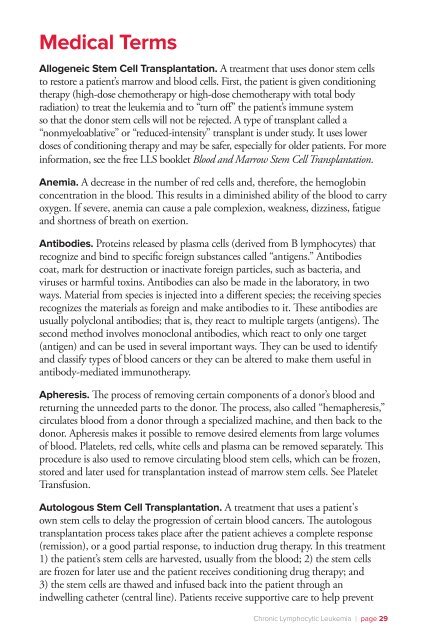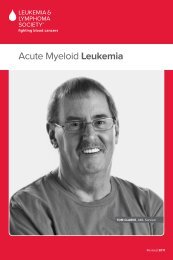Chronic Lymphocytic Leukemia - The Leukemia & Lymphoma Society
Chronic Lymphocytic Leukemia - The Leukemia & Lymphoma Society
Chronic Lymphocytic Leukemia - The Leukemia & Lymphoma Society
Create successful ePaper yourself
Turn your PDF publications into a flip-book with our unique Google optimized e-Paper software.
Medical Terms<br />
Allogeneic Stem Cell Transplantation. A treatment that uses donor stem cells<br />
to restore a patient’s marrow and blood cells. First, the patient is given conditioning<br />
therapy (high-dose chemotherapy or high-dose chemotherapy with total body<br />
radiation) to treat the leukemia and to “turn off” the patient’s immune system<br />
so that the donor stem cells will not be rejected. A type of transplant called a<br />
“nonmyeloablative” or “reduced-intensity” transplant is under study. It uses lower<br />
doses of conditioning therapy and may be safer, especially for older patients. For more<br />
information, see the free LLS booklet Blood and Marrow Stem Cell Transplantation.<br />
Anemia. A decrease in the number of red cells and, therefore, the hemoglobin<br />
concentration in the blood. This results in a diminished ability of the blood to carry<br />
oxygen. If severe, anemia can cause a pale complexion, weakness, dizziness, fatigue<br />
and shortness of breath on exertion.<br />
Antibodies. Proteins released by plasma cells (derived from B lymphocytes) that<br />
recognize and bind to specific foreign substances called “antigens.” Antibodies<br />
coat, mark for destruction or inactivate foreign particles, such as bacteria, and<br />
viruses or harmful toxins. Antibodies can also be made in the laboratory, in two<br />
ways. Material from species is injected into a different species; the receiving species<br />
recognizes the materials as foreign and make antibodies to it. <strong>The</strong>se antibodies are<br />
usually polyclonal antibodies; that is, they react to multiple targets (antigens). <strong>The</strong><br />
second method involves monoclonal antibodies, which react to only one target<br />
(antigen) and can be used in several important ways. <strong>The</strong>y can be used to identify<br />
and classify types of blood cancers or they can be altered to make them useful in<br />
antibody-mediated immunotherapy.<br />
Apheresis. <strong>The</strong> process of removing certain components of a donor’s blood and<br />
returning the unneeded parts to the donor. <strong>The</strong> process, also called “hemapheresis,”<br />
circulates blood from a donor through a specialized machine, and then back to the<br />
donor. Apheresis makes it possible to remove desired elements from large volumes<br />
of blood. Platelets, red cells, white cells and plasma can be removed separately. This<br />
procedure is also used to remove circulating blood stem cells, which can be frozen,<br />
stored and later used for transplantation instead of marrow stem cells. See Platelet<br />
Transfusion.<br />
Autologous Stem Cell Transplantation. A treatment that uses a patient's<br />
own stem cells to delay the progression of certain blood cancers. <strong>The</strong> autologous<br />
transplantation process takes place after the patient achieves a complete response<br />
(remission), or a good partial response, to induction drug therapy. In this treatment<br />
1) the patient’s stem cells are harvested, usually from the blood; 2) the stem cells<br />
are frozen for later use and the patient receives conditioning drug therapy; and<br />
3) the stem cells are thawed and infused back into the patient through an<br />
indwelling catheter (central line). Patients receive supportive care to help prevent<br />
<strong>Chronic</strong> <strong>Lymphocytic</strong> <strong>Leukemia</strong> I page 29

















